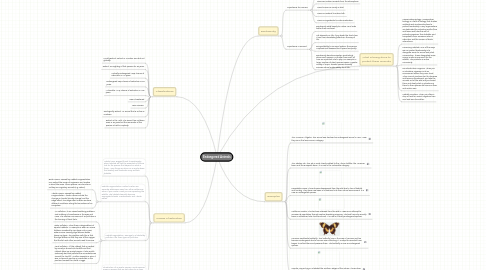
1. Classifications
1.1. Locally Extinct- Extinct in a certain area but not globally.
1.2. Extinct- Do sighting of that species for 50 years.
1.3. Critically Endangered- 50% chance of extinctiion in 10 years.
1.4. Endangered 20% chance of extinction in 20 years.
1.5. Vulnerable- 10 % chance of extinction in 100 years.
1.6. Near Threatened
1.7. Less Concern
1.8. Ecologically Extinct- An animal that is so few in numbers.
1.9. Extinct in the Wild- The animal has not been seen in 50 years but the remainder of the species is held in captivity.
2. Causes of Extinction
2.1. Habitat Loss- Biggest threat to Biodiversity, when habitats are lost the essentials of life are lost for the species that depend on what is there. Many things are done on a regular basis that destroy and eradicate many animals’ habitats.
2.2. Habitat Fragmentation- Refers to when we separate wilderness areas from other wilderness areas, if you create a road you are separating the wildlife. The habitats basically become segregated islands. Creates Biotic and Abiotic issues.
2.2.1. Biotic Issues- Caused by Habitat Fragmentation. Can restrict the range of organisms as it creates 2 island like areas. Some species can also starve as they are migratory animals (e.g. Zebra).
2.2.2. Abiotic Issues- Caused by Habitat Fragmentation. Abiotic issues include the change in climate (climate change) and the edge effect. The edge effect is when we have different conditions along the boundaries of an ecosystem.
2.3. Habitat Degradation- Damage to a habitat by pollution, the three types of pollution.
2.3.1. Air Pollution- It can cause breathing problems and irritating of membranes in the eyes and nose. The number one source of air pollution is the burning of fossil fuels.
2.3.2. Water Pollution- When there is degradation of aquatic habitats. An example is when an access fertilizer is washed by rain down into a main water source, causing algal blooms better known as algae. The problem with this is that the algal blooms is that they use all the oxygen that the fish and other animals need to survive.
2.3.3. Land Pollution- All the rubbish that is created by society is buried into landfills and that rubbish takes up animal’s space. It also smells extremely bad and pollutes the immediate area around the land fill. Another example is DDT, it was a chemical used as an insecticide in the past and caused thin shells in eggs.
2.4. Introduction of an exotic species- exotic species means a species that are not native to an area. These animals grow at a large rate due to lack of predators and competition.
3. Examples
3.1. The American Alligator- This animal was declared an endangered animal in 1967. Now they are in the less concern category.
3.2. The Tibetan Yak- This yak is most closely related to the African buffalo, the American bison and the European bison. It is now in the vulnerable category.
3.3. Przewalski’s Horse- These horses disappeared from the wild due to loss of habitat and hunting. They have now been re-introduced into their natural environment. It is now an endangered species.
3.4. California Condor- This bird was released from the wild in 1988 as an attempt to increase its population through captive breeding programs. This bird has only recently been re-introduced into its environment. It is now a critically endangered species.
3.5. Homerus Swallowtail Butterfly- This butterfly lives in the area of Jamaica and has become endangered due to humans over collecting it. To stop this scientist have begun to collect them and preserve them. This butterfly is now an endangered species.
3.6. Scimitar Horned Oryx- Inhabited the southern edges of the Sahara. It now does not exist in the wild.
4. What is being done to protect these animals?
4.1. Conservation Biology- Conservation biology is a field of biology that studies methods and implements plans to protect biodiversity. Many organisations are dedicated to protecting earth’s flora and fauna and have the aim of protecting species, their habitats, and ecosystems from excessive rates of extinction and the erosion of biotic interactions.
4.2. Preserving Habitats- One of the ways we can protect biodiversity is to designate areas for animal and plant conservation. These designated areas ensure a safe environment for the wildlife. This protects an entire community.
4.3. Re-introduction Programs- When you re-introduce organisms into an environment where they once lived. When animal numbers start to decrease and become threatened, you take the animals out of the wild and you breed them and slowly start re-introducing them to their species old home on new and similar area.
4.4. Habitat Corridors- When you allow a strip of land for animal migration from one land area to another.
5. Biodiversity
5.1. Importance for Humans
5.1.1. Provides humans with Oxygen
5.1.2. Removes Carbon Dioxide from the atmosphere.
5.1.3. Gives humans a variety in diet.
5.1.4. Gives us material to make cloth.
5.1.5. Gives us ingredients to make medication.
5.2. Importance in General
5.2.1. Biodiversity adds beauty to nature, corn looks better then rainforest.
5.2.2. Life depends on life, if you break the food chain it can have devastating effects on the way of life.
5.2.3. Brings stability to an equal system, the species is spread and diseases don't spread as quickly.
5.2.4. Biodiversity boosts ecosystem productivity where each species, no matter how small, all have an important role to play. For example, a larger number of plant species means a greater variety of crops. Greater species diversity ensures natural sustainability for all life.
